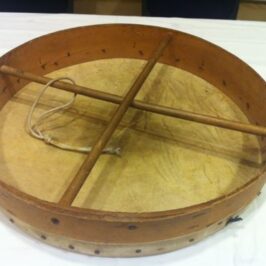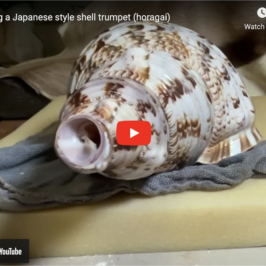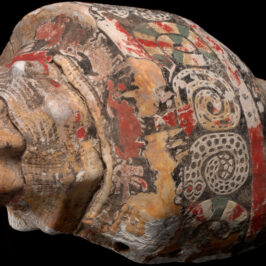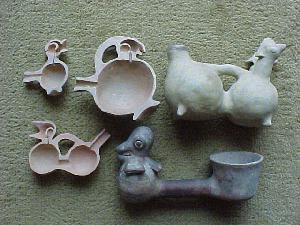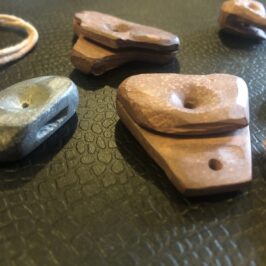The slit drum is indigenous to many cultures around the world. Though in this article we will be examining the mesoamerican (includes much of modern Mexico and Central America) slit drum specific to the Americas (pre and post contact). These specific slit drums are distinguished by their stylistic design characteristics; such as the H shaped slits and their open bottoms. Many of the other variations from around the world, such as African versions, may have the H shaped or straight slits, but usually have solid bottoms.
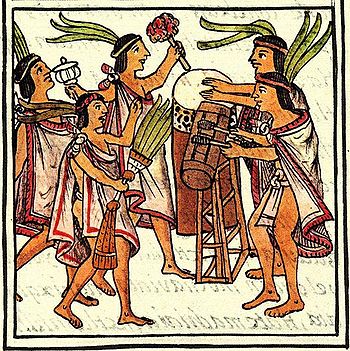
Drawing from the 16th century Florentine Codex showing a One Flower ceremony with a teponaztli (foreground) and a huehuetl (background). Wikipedia
These mesoamerican versions are called by many different names; such as mayohuacan (Taino or Arawak) or teponaztli (Aztec). Archeological records of these drums can be found in Aztec and Mayan written records that remain and the records of the European explorers of the New World. These drums usually have spiritual uses for various ceremonies, but have become used for many other occasions since post-contact.

The slit drum isn’t a true drum, but considered an idiophone. An idiophone is a musical instrument that creates sound primarily by the instrument as a whole vibrating—without the use of strings or membranes such as skin. These drums can be made from hollow bamboo, but is usually built from hollowed logs or boxes. Some slit drums from other cultures may have on or more straight slits, though most of the mesoamerican versions have an H shaped slit, as we mentioned earlier. Each tongue on the mesoamerican styles can have different notes, depending on the thickness and size/length of the slits themselves.

Bamileke drummers in Cameroon’s West Province.
In Africa slit drums are usually hollow logs with the ends closed off to create resonate chambers, for greater sound. Many African cultures have used slit drums for communication over long distances, and they have placed these large slit drums in locations for greater sound distribution, making it easier to communicate. Many of these African cultures have also developed techniques and patterns for advanced message transmission from village to village. These techniques have made it much easier to communicate for thousands of years, before the use of electronic devices or in areas without electronic capabilities to this day.
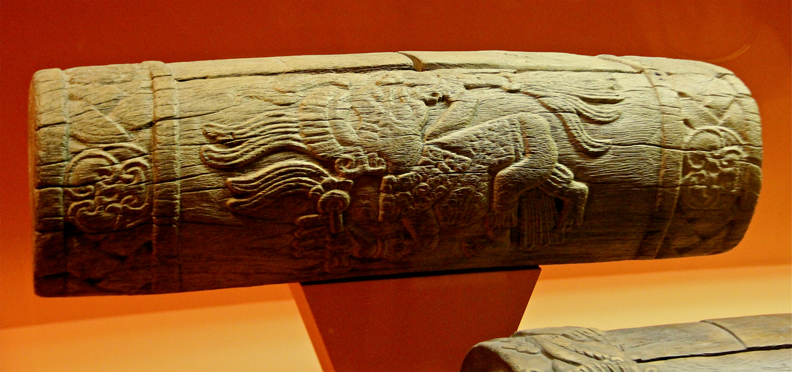
Teponaztli drum. Post-Classic Nahua/Aztec. Museum of Natural History, New York, 2012. (R. Haskett)
The Aztecs used these drums in dances, poetry, celebrations (as shown in the Florentine Codex image above) or in warfare as a means of communication. As with many sacred ceremonial tools or instruments had to be cared for in special ways, there are stories of these Aztec version being “fed” the blood of sacrificed humans and animals from the Spanish invaders of the 1600’s.
The Aztec teponaztli was one of the most advanced version of slit drums of the past. This culture used rubber footings or bases to help the resonate properties, and they also made rubber ended mallets to help create a clear tonal quality when used. Many of the Aztec versions had multiple notes, and have been the inspiration for the wooden tongue drums that are well known in contemporary musical instrument circles.

As a person of Taino descent, and a Taino ceremonial leader in training, I have a high regard for the Taino version of the slit drum, known as the Mayohuacan. In our culture this drum was the main drum used by our ancestors, since the humid environment of the Caribbean wasn’t suited for skin covered drums commonly found in North American cultures and beyond. Though many people think of Native American drums are the common skin covered hand drum or large powwow drums we know today, our Caribbean ancestors commonly used slit drums. These drums are still used today for many traditional ceremonies.
Sources:
- Wikipedia- Teponaztli
- People of One Fire- https://peopleofonefire.com/
- American Museum of Natural History
- CaneyCircle.org
- https://aztecart2017.ace.fordham.edu/exhibits/show/jaguar-eagle-glyph-teponaztli-/teponaztlianalysis
- https://www.hofstra.edu/pdf/community/museum/teponaztl.pdf
- https://blogs.uoregon.edu/mesoinstitute/about/curriculum-unit-development/ethnomusicology/

